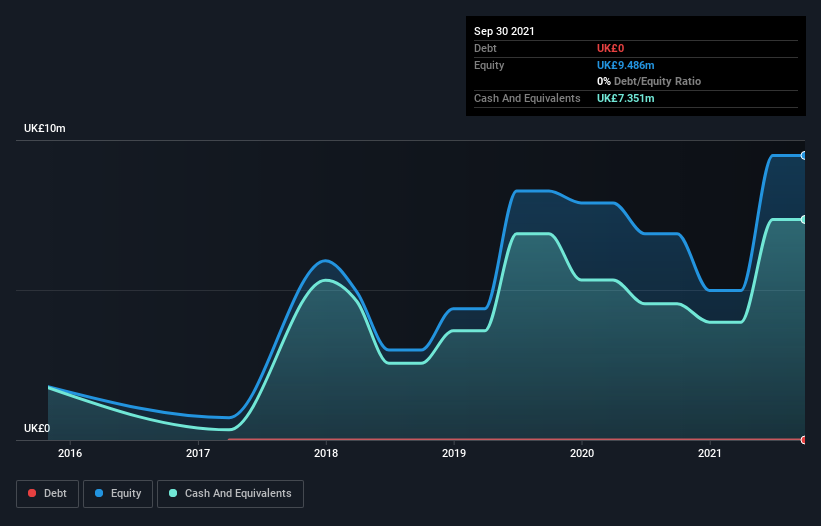We're Interested To See How Sosandar (LON:SOS) Uses Its Cash Hoard To Grow
There's no doubt that money can be made by owning shares of unprofitable businesses. For example, biotech and mining exploration companies often lose money for years before finding success with a new treatment or mineral discovery. But while history lauds those rare successes, those that fail are often forgotten; who remembers Pets.com?
So, the natural question for Sosandar (LON:SOS) shareholders is whether they should be concerned by its rate of cash burn. In this article, we define cash burn as its annual (negative) free cash flow, which is the amount of money a company spends each year to fund its growth. Let's start with an examination of the business' cash, relative to its cash burn.
View our latest analysis for Sosandar
How Long Is Sosandar's Cash Runway?
A cash runway is defined as the length of time it would take a company to run out of money if it kept spending at its current rate of cash burn. As at September 2021, Sosandar had cash of UK£7.4m and no debt. Importantly, its cash burn was UK£2.6m over the trailing twelve months. So it had a cash runway of about 2.8 years from September 2021. Importantly, though, the one analyst we see covering the stock thinks that Sosandar will reach cashflow breakeven before then. In that case, it may never reach the end of its cash runway. You can see how its cash balance has changed over time in the image below.
How Well Is Sosandar Growing?
Happily, Sosandar is travelling in the right direction when it comes to its cash burn, which is down 61% over the last year. This reduction was no doubt supported by its strong revenue growth of 91% in the same period. Overall, we'd say its growth is rather impressive. Clearly, however, the crucial factor is whether the company will grow its business going forward. So you might want to take a peek at how much the company is expected to grow in the next few years.
How Hard Would It Be For Sosandar To Raise More Cash For Growth?
We are certainly impressed with the progress Sosandar has made over the last year, but it is also worth considering how costly it would be if it wanted to raise more cash to fund faster growth. Companies can raise capital through either debt or equity. One of the main advantages held by publicly listed companies is that they can sell shares to investors to raise cash and fund growth. By comparing a company's annual cash burn to its total market capitalisation, we can estimate roughly how many shares it would have to issue in order to run the company for another year (at the same burn rate).
Sosandar has a market capitalisation of UK£61m and burnt through UK£2.6m last year, which is 4.3% of the company's market value. That's a low proportion, so we figure the company would be able to raise more cash to fund growth, with a little dilution, or even to simply borrow some money.
So, Should We Worry About Sosandar's Cash Burn?
It may already be apparent to you that we're relatively comfortable with the way Sosandar is burning through its cash. For example, we think its revenue growth suggests that the company is on a good path. And even its cash burn reduction was very encouraging. It's clearly very positive to see that at least one analyst is forecasting the company will break even fairly soon. After considering a range of factors in this article, we're pretty relaxed about its cash burn, since the company seems to be in a good position to continue to fund its growth. Readers need to have a sound understanding of business risks before investing in a stock, and we've spotted 3 warning signs for Sosandar that potential shareholders should take into account before putting money into a stock.
If you would prefer to check out another company with better fundamentals, then do not miss this free list of interesting companies, that have HIGH return on equity and low debt or this list of stocks which are all forecast to grow.
Have feedback on this article? Concerned about the content? Get in touch with us directly. Alternatively, email editorial-team (at) simplywallst.com.
This article by Simply Wall St is general in nature. We provide commentary based on historical data and analyst forecasts only using an unbiased methodology and our articles are not intended to be financial advice. It does not constitute a recommendation to buy or sell any stock, and does not take account of your objectives, or your financial situation. We aim to bring you long-term focused analysis driven by fundamental data. Note that our analysis may not factor in the latest price-sensitive company announcements or qualitative material. Simply Wall St has no position in any stocks mentioned.

 Yahoo Finance
Yahoo Finance 
